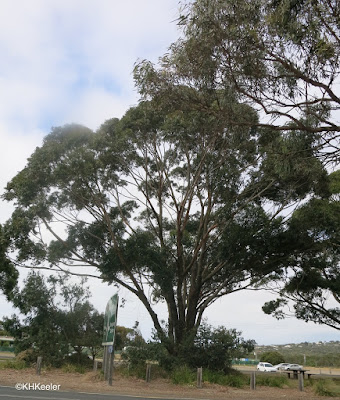Aspen - Aspen is an American plant that is an excellent dye plant. It doesn’t make reds and oranges but rather hot yellows and strong olive greens. Quaking aspen (Populus tremuloides) has the widest distribution of any tree in North America (link) so many people can easily gather it and learn to dye with it. One nice thing about trees as dye plants: it is relatively easy to get enough leaves to fill a dyepot. Much of the written dyeing tradition is from Europe, so although there are American plants that make fine dyes, they are less-often described or sold.
 |
Silk dyed with aspen leaves, irregularly applied to make leafy pattern.
Left, iron mordant; right, alum mordant. |
Cottonwood, Populus deltoides, is closely related to aspen. Like aspen, its leaves make strong yellows and olives greens.
 |
| Cottonwood |
Poinsettia - I researched poinsettia (Euphorbia pulcherrima, spurge family, Euphorbiaceae) for a talk in Loveland. One reference said “Aztecs made a red dye from poinsettia bracts” (Blog on poinsettia link.) We had to try it. Sheron Buchele Rowland and I made nice reds from poinsettia bracts. A year later, the color seems stable.
 |
| Red poinsettia (Euphorbia pulcherimma) bracts |
 |
| White silk dyed with poinsettia bracts, alum mordant. |
Sweet woodruff - Gallium odoratum (madder family, Rubiaceae). Madder, Rubia tinctoria, is perhaps the most famous plant for making red dyes. Sweet woodruff is related to it, but much smaller. I have a lot of sweet woodruff in my yard and it had grown into numerous places where I could easily pull it up. Like madder, the dye is in the roots. I got a reddish orange very similar to madder's. Of course, I got only a couple cups of dye, not enough do even a small piece of cloth well, but if you had enough sweet woodruff and enough enthusiasm, you could. And, sweet woodruff is a pleasant plant with pretty white flowers (below). Madder is an awkward, sprawling plant with sharp edges on its leaves and stem that make it unpleasant to work around.
 |
| Sweet woodruff, Galium odoratum, in bloom |
Coreopsis! Coreopsis is a genus of 70-80 species native to central North America. Common names for them are coreopsis and tickseed (referring to the small, flat, dark seeds). In the sunflower family, Asteraceae, they make very attractive garden flowers. All the species I've tried are good dye plants. The annual, Coreopsis tinctoria, called plains coreopsis or golden tickseed, is a spectacular dye plant. The flowers make strong, permanent oranges, yellows and olive greens (with different mordants), very quickly and efficiently.
 |
| Coreopsis |
 |
| Coreopsis tinctoria, plains coreopsis, golden tickseed |
 |
| Silk dyed with coreopsis, different mordants. |
Sheron Buchele-Rowland (her blog) got the pattern below by applying coreopsis flowers directly to mordanted silk: look how strong the dye in individual flowers was!
 |
| Imprint of coreopsis flowers |
Okay, one more dyed-with-coreopsis photo, because I think its such a great dye plant. Coreopsis flowers made all those colors:
 |
| All dyed with coreopsis! |
Most plant-based dyes lost their economic importance in the 1850s when analine dyes were discovered. But dyeing is a wonderful experience: you mix leaves or flowers in water treated with compounds to facilitate dyeing, add yarn or cloth and wow! transfer the color to the cloth! Getting some color is easy, getting a particular color is a skill. Whether just seeing what happens or carefully creating a particular shade, I find dyeing very, very satisfying.
Consequently, plants about which I can say "that's a good dye plant" are among my favorite plants.
Comments and corrections welcome.
Kathy Keeler, A Wandering Botanist
Join me on Facebook: https://www.facebook.com/AWanderingBotanist












Now this is really good post, I love the idea of getting inspiration from the nature. You did really great job here, thanks for sharing it
ReplyDelete